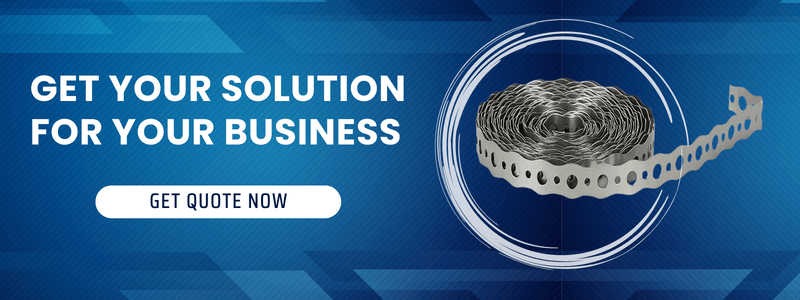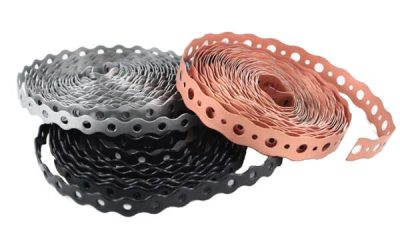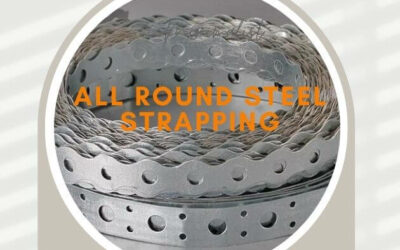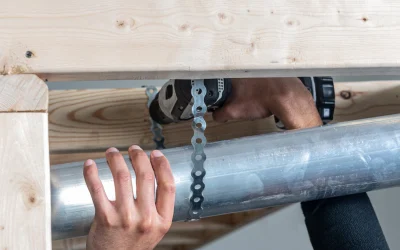Metal hanger straps, also known as perforated strapping, are versatile and durable fasteners used for hanging and supporting pipes, ducts, cables, and more. Made from galvanized or stainless steel, these straps come in a range of widths, thicknesses, and weight limits to accommodate various applications. In this comprehensive guide, we’ll explore everything you need to know about metal hanger straps, from common uses to choosing the right product.

What Are Metal Hanger Straps?
Metal hanger straps are strips of steel that have been perforated with holes or slots along their length. The perforations allow for adjustability and secure fastening when wrapped around pipes, conduits, HVAC ductwork, and more.
They are an alternative to wire hangers and provide a stronger, more rigid support. The slots or holes allow for bolts, screws, or other hardware to fasten the strap and hold it in place. The flexibility of these straps allows them to conform to a variety of shapes and sizes.
Common types of metal hanger straps include:
- Galvanized steel – Low carbon steel with a zinc coating for corrosion resistance. Most economical option.
- Stainless steel – Higher corrosion and rust resistance. Used in caustic or salty environments.
- PVC-coated – Galvanized steel with a vinyl coating to prevent corrosion. Often used outdoors. Home Depot and other hardware stores carry various options like home depot metal hanger straps for common home applications.
Common Uses for Metal Hanger Straps
Metal hanger straps have many uses in residential, commercial, and industrial settings. Some of the most popular applications include:
Hanging Pipe and Conduit
One of the most frequent uses is for hanging and supporting pipes, including:
- Plumbing pipes
- HVAC pipes
- Electrical conduit
- Industrial process piping
The straps cradle the pipe while providing a strong connection point for hanging from overhead structures. Perforations allow for adjustments to properly support the pipe. Heavy duty metal straps with holes are ideal for large pipes and conduits.
Mounting Ductwork
Metal strapping is also commonly used for suspending ductwork in HVAC systems. The straps can wrap fully around ducts or fasten to the sides for support. Perforations give flexibility in sizing and adjustments. Galvanized metal duct hanger straps are commonly used.
Cable Management
Electrical cables, network cabling, and wire bundles can be neatly organized and routed using metal hanger straps. Simply running cables through the perforations keeps everything in place.
Securing Solar Panels
The durability of metal strapping makes it ideal for mounting solar panels to roof racks and frames. The straps can securely fasten panels while allowing for precise angle adjustments.
Construction Applications
Metal straps have a number of uses in building construction. They can be used to hang ductwork, conduits, or plumbing during the construction process before walls and ceilings are erected. Strapping can also reinforce stud walls and anchor floor joists. Perforated pipe hanger straps allow for easy adjustments.
Automotive
Metal straps find application in the automotive industry, such as for mounting exhaust systems. Their durability withstands vibration and heat.
General Fixings & Hanging
In many cases, a simple metal hanger strap can provide a convenient method for hanging or fastening objects. Their strength and adjustability lend well to hanging tools, storage racks, gates, signs, and anything else that needs a secure mount. Sheet metal hanger straps work well for general repairs and hanging around the home.
What To Look For When Buying Metal Hanger Straps
When selecting metal hanger straps, there are several key factors to consider depending on your intended application:
Material
The most common options are galvanized steel for durability and corrosion resistance at a low cost, or stainless steel for maximum durability in harsh environments. PVC-coated straps add an extra layer of corrosion resistance.
Width
Common widths range from 1/2 inch up to 4 inches. The width needed depends on the size of the application and how much support is required. Wider straps can support heavier loads. 2 inch wide metal strapping is a popular general purpose size.
Thickness/Gauge
Thickness is usually indicated by the gauge – lower gauge numbers indicate thicker, heavier straps. Thicker straps are stronger. 22 gauge is suitable for light duty applications while 14 gauge can support very heavy loads.
Perforation Type
The perforations allow for securing the strap around an object. Look for holes, slots, or a combination of both to provide adjustability.
Weight Limit
Select a strap rated for the load you need to support. Weight limits can range from 50 lbs for light duty up to thousands of pounds for heavy industry.
Length
Straps usually come in lengths ranging from a couple feet up to 10 feet or more. Pick the appropriate size based on your application and ability to cut to length as needed.
Certifications
Look for straps certified to safety standards like UL for quality assurance. Galvanized coatings should meet ASTM A653 standards.
Top Brands of Metal Hanger Straps
Some of the top manufacturers of metal strapping products include:
- B-Line – Offers a full range of strap sizes and materials with UL Classification. Trusted brand.
- Anvil International – Leading manufacturer of hangers, braces, fasteners, and fittings. Durable products.
- Electriduct – Specializes in hangers and cable tray products, with a line of metal strapping.
- Ideal Industries – Known for conduits, wire, and tools also makes steel hangers and straps.
- Metaline – Wide selection of perforated metal hangers for HVAC, electrical, and construction industries.
Home Depot and Lowes also offer various house brand metal hanger straps for common applications. Look for straps rated to meet UL safety standards for quality assurance.
How to Use Metal Hanger Straps
Using metal hanger straps is a simple process that can be done with basic hand tools. Here are the basic steps:
- Measure the item to be supported and cut the strap to the required length using tin snips. Leave 2-3 holes extra on each end.
- Place the strap around the item. For a pipe, situate it in the concave part of the strap.
- Overlap the strap ends if needed to form a secure circle. Align the holes on each end.
- Select bolts that will fit through the strap holes. Use lock washers and nuts to securely fasten.
- Use screw eyes or other hardware to attach hanging wires from overhead structures. Ensure everything is plumb.
- Check that the strap is firmly holding the item and not slipping. Tighten hardware again if needed.
- For heavy loads, use multiple strapping hang points and support both vertically and horizontally.
Follow manufacturer’s specs for weight limits, proper installation, and safety precautions. With robust materials and secure fastening, metal hanger strap provides a versatile solution for hanging and supporting all types of industrial and residential items. Proper selection and installation ensures years of durable service.
Frequently Asked Questions About Metal Hanger Straps
What is a perforated strapping material?
Perforated strapping features rows of holes or slots punched along the length of a metal strip, usually steel. This creates adjustable positions for fastening the straps. It allows for conforming the straps to different sizes and shapes.
What is stronger, 22 gauge metal hanger strap or 24 gauge metal hanger strap?
22 gauge strapping is stronger than 24 gauge. The gauge refers to the thickness of the metal. Lower gauge numbers indicate increased thickness. A 22 gauge strap is approximately 0.0299 inches thick, while 24 gauge is around 0.0239 inches thick. The added thickness of 22 gauge allows it to support heavier loads.
What is the weight limit for metal strapping?
The weight limit varies substantially based on the size and gauge of the strapping used. Typical home/hobbyist strapping may be 24 gauge and support 50-100 lbs. Heavy duty industrial strapping can be 3/8” thick or more and hold over 2000 lbs. Always check manufacturer ratings for the product’s recommended weight capacity.
Can metal hanger straps be used outdoors?
Standard galvanized steel straps can be used outdoors as the zinc coating protects against corrosion. For extreme outdoor environments, straps made of stainless steel or red iron offer maximum corrosion resistance. PVC coated straps are also suitable for outdoor use.
How long should metal straps overlap when wrapped around an object?
As a general rule of thumb, a minimum overlap of 1-2 inches is recommended when wrapping a metal hanger strap around something. More overlap provides greater holding strength. The goal is to have enough overlap so the strap forms a complete circle around the object being hung.
How are metal straps fastened?
Metal straps are most often fastened using bolts, screws, or rivets that go through the perforated holes/slots. Use lock washers and nuts on the bolt ends for a tight, vibration-proof connection. Hanger wires can then be attached to the installed straps using screw eyes or hooks.
Can you bend metal hanger straps?
Thinner gauge straps can be bent by hand to fit a particular application, but anything over 22 gauge becomes difficult to bend without tools. Bending too sharply can also compromise the strength. For best results, use a tubing bender to bend straps to match the desired shape. Only bend along the same axis as the perforations.
Can metal straps get wet?
Metal hanger straps made of galvanized or stainless steel can get wet without issue. The coatings prevent rust and corrosion. PVC-coated straps are also water resistant. Avoid submerging straps in standing water when possible, but incidental moisture is fine.
Can metal hanger straps be painted?
Yes, metal straps can be painted after installation for aesthetic purposes or added corrosion resistance. Clean the surface first and use an appropriate primer and finish coat of spray paint. Do not paint stainless steel straps. Avoid painting areas where hardware connects.
Conclusion
Metal hanger straps offer an affordable and robust solution for supporting pipes, ducts, conduits, cables, and more. Their perforated design allows for adjustability while their steel construction provides durability even when holding heavy loads. By selecting the proper size, thickness, and material, metal straps can be installed to securely hang industrial or residential items in a wide range of settings. With the proper installation know-how, these versatile straps will provide reliable support for years to come.
Galvanized Steel Strapping vs Stainless Steel Strapping: A Comprehensive Comparison
Introduction When it comes to securing and bundling materials, steel strapping is a popular choice due to its strength, durability, and versatility. However, not all steel strapping is created equal. Two of the most widely used options are galvanized steel strapping...
How To Install All Round Steel Strapping?
If you're in the construction or plumbing industry, you know that hanging pipes securely is crucial for a successful installation. One of the most reliable methods for supporting pipes is using all round steel strapping, also known as banding. This versatile material...
28-Gauge Galvanized Pipe Hanger Strap: The Unsung Hero of Plumbing Installations
Introduction Have you ever stopped to think about the unsung heroes that hold your plumbing system together? Those unassuming yet essential components that ensure your pipes stay securely in place? Well, let me introduce you to the humble 28-gauge galvanized pipe...

Justin Wong
Hi, I’m Justin, the technical engineer of Jiangmen Masters. We’ve been running a factory in China that makes metal hanger strap for 16 years now, and the purpose of this article is to share the knowledge related to metal hanger strap from a Chinese supplier’s perspective.




